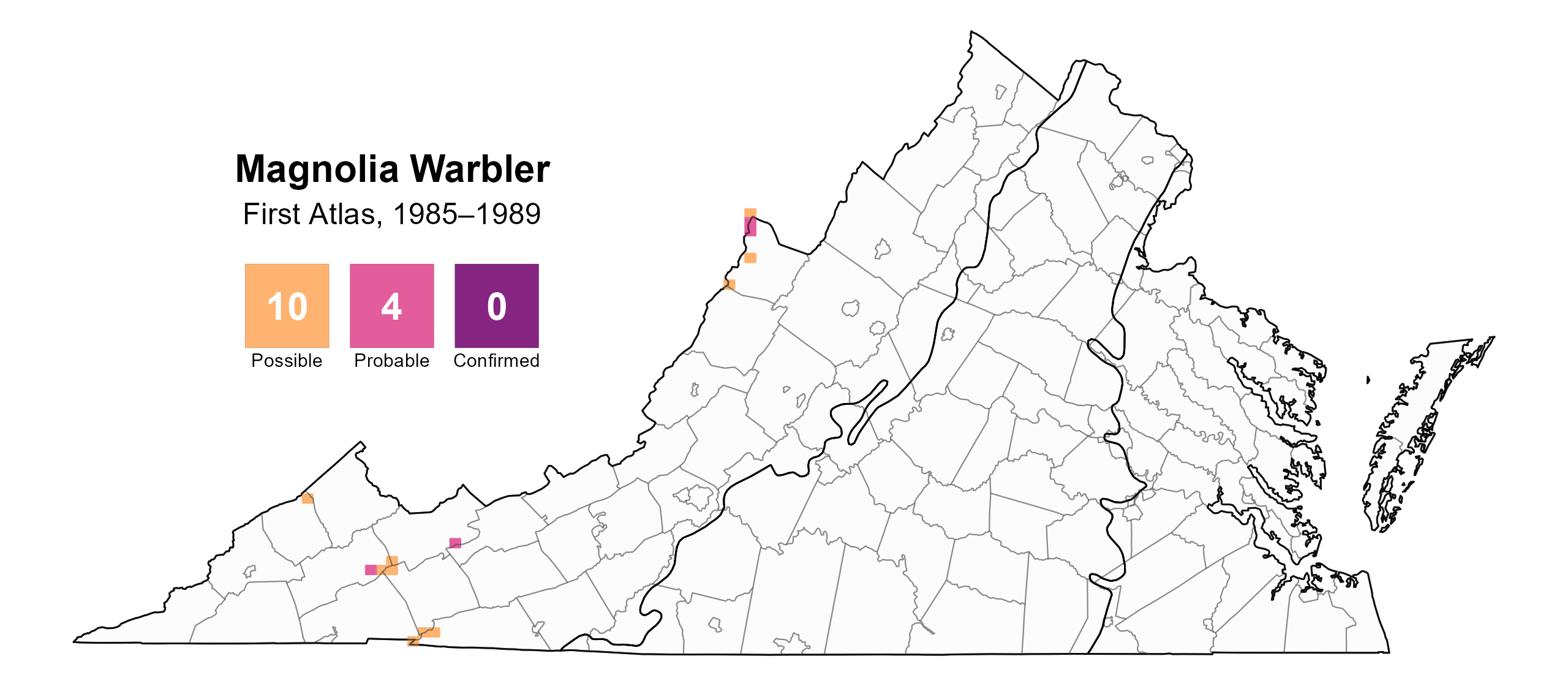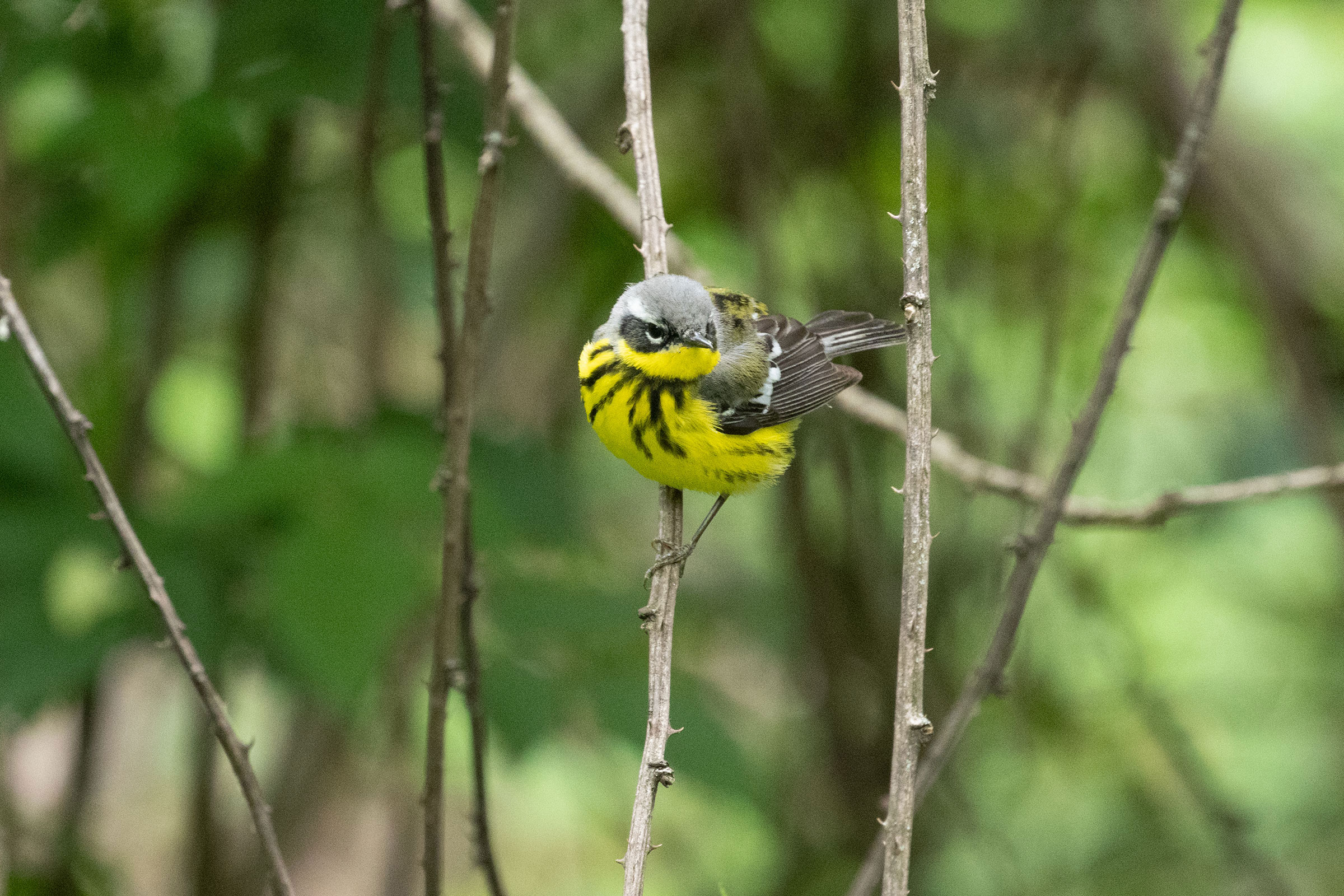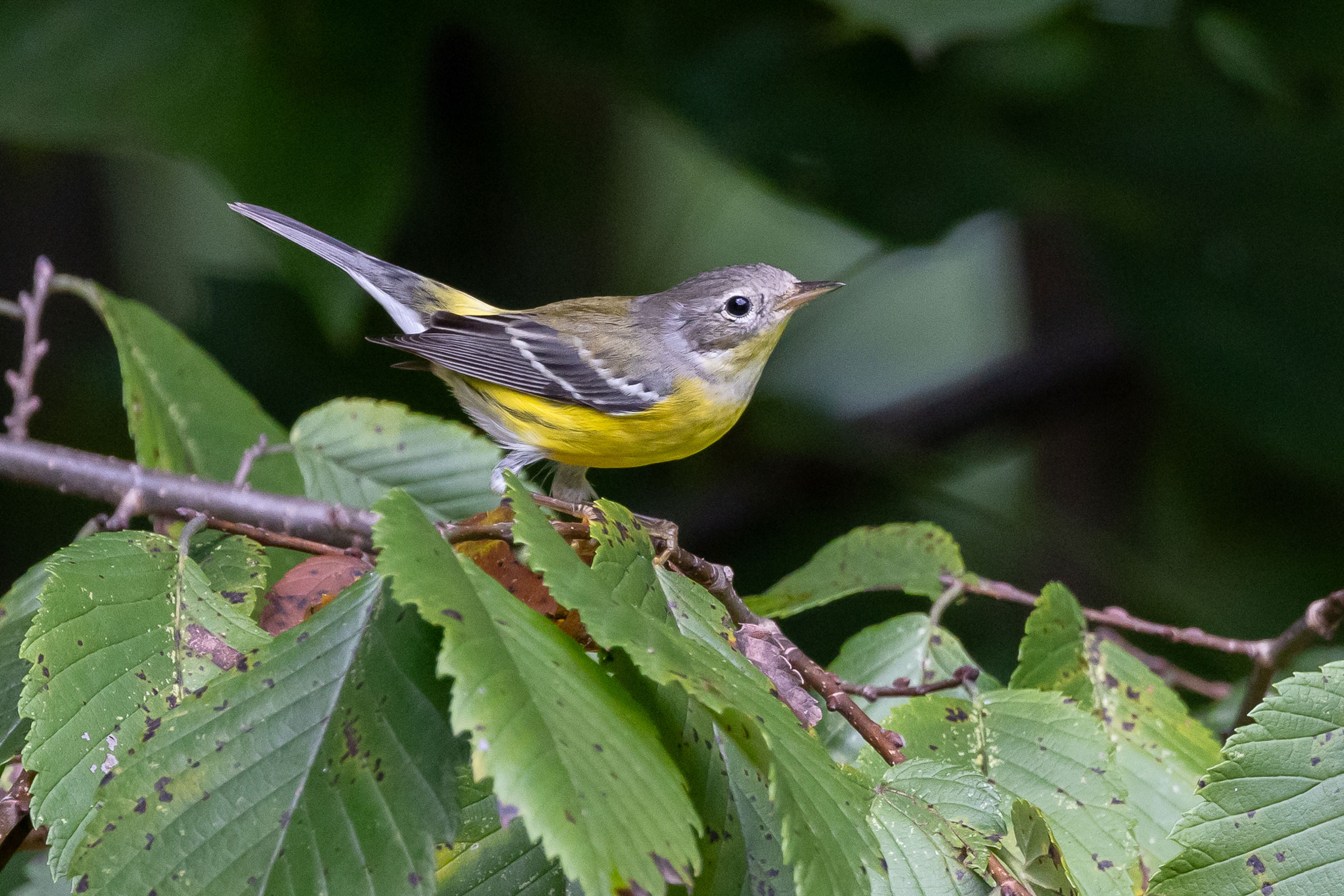Introduction
Magnolia Warblers breed in boreal forests amid dense stands of conifers. Their primary breeding distribution extends from northern Pennsylvania through the New England states and then west through the Upper Great Lakes region and Canada. Most range maps do not include Virginia as part of the Magnolia Warbler’s breeding range; however, there are small populations that use high-elevation coniferous forest within the Mountains and Valleys region, such as in the Mount Rogers region and Highland, Russell, and Wise Counties (Lee 1985; Rottenborn and Brinkley 2007; Dunn and Hall 2020).
Breeding Distribution
Magnolia Warblers are found only in the Mountains and Valleys region. Within most of this region, they are absent or only slightly likely to occur, except for isolated areas where their occurrence is moderate to high in high-elevation forested habitats (Figure 1). Accordingly, their likelihood of occurring in a block increase as elevation increases. Their distribution includes small sections of Augusta, Bath, Grayson, Highland, and Rockingham Counties.
Magnolia Warbler distribution could not be developed for the First Atlas due to limited breeding data; thus, no change in distribution was able to be modeled. For more information on where they occurred during the First Atlas, please see the Breeding Evidence section.

Figure 1: Magnolia Warbler breeding distribution based on probability of occurrence (Second Atlas, 2016–2020). This map indicates the probability that this species will occur in an Atlas block (an approximately 10 mi2 [26 km2] survey unit) based on environmental (including habitat) factors and after adjusting for the probability of detection (variation in survey effort among blocks). Blocks in gray are outside the species’ core range and were not modeled.
Breeding Evidence
Magnolia Warblers were confirmed breeders in seven blocks and three counties (Grayson, Highland, and Russell) and found to be probable breeders in five additional counties (Augusta, Montgomery, Rockingham, Shenandoah, and Smyth) (Figure 2). No confirmed breeders were observed during the First Atlas; however, there were several probable breeders (Figure 3).
Breeding was confirmed primarily through observations of adults carrying food, which was first observed on June 6. This behavior continued to be observed through July 20 (Figure 4). In addition, one occupied nest was recorded on July 9. Feeding young was the last breeding observation to be recorded on August 15.
For more general information on the breeding habits of this species, please refer to All About Birds.

Figure 2: Magnolia Warbler breeding observations from the Second Atlas (2016–2020). The colored boxes illustrate Atlas blocks (approximately 10 mi2 [26 km2] survey units) where the species was detected. The colors show the highest breeding category recorded in a block. The numbers within the colors in the legend correspond to the number of blocks with that breeding evidence category.

Figure 3: Magnolia Warbler breeding observations from the First Atlas (1985–1989). The colored boxes illustrate Atlas blocks (approximately 10 mi2 [26 km2] survey units) where the species was detected. The colors show the highest breeding category recorded in a block. The numbers within the colors in the legend correspond to the number of blocks with that breeding evidence category.

Figure 4: Magnolia Warbler phenology: confirmed breeding codes. This graph shows a timeline of confirmed breeding behaviors. Tick marks represent individual observations of the behavior.
Population Status
Limited detections during the point count surveys prevented the development of an abundance model for the Magnolia Warbler. However, data from the North American Breeding Bird Survey (BBS) for the Appalachian region (BBS trends at the Virginia scale were not credible) showed that the Magnolia Warbler increased at a significant annual rate of 1.37% from 1966 to 2022, and between Atlas periods, the population increased at a significant 1.45% per year from 1987–2018 (Hostetler et al. 2023; Figure 5).

Figure 5: Magnolia Warbler population trend for the Appalachian Mountains as estimated by the North American Breeding Bird Survey. The vertical axis shows species abundance; the horizontal axis shows the year. The solid line indicates the estimated population trend; there is a 97.5% probability that the true population trend falls between the dashed lines. The shaded bars indicate the First and Second Atlas periods.
Conservation
Although Magnolia Warblers are rare in Virginia, they are common and widespread throughout their range (Dunn and Hall 2020). They are not considered a species of special concern; however, any efforts focused on conserving high-elevation forests in the state will also benefit this species.
Interactive Map
The interactive map contains up to six Atlas layers (probability of occurrence for the First and Second Atlases, change in probability of occurrence between Atlases, breeding evidence for the First and Second Atlases, and abundance for the Second Atlas) that can be viewed one at a time. To view an Atlas map layer, mouse over the layer box in the upper left. County lines and physiographic regional boundaries (Mountains and Valleys, Piedmont, and Coastal Plain) can be turned on and off by checking or unchecking the box below the layer box. Within the map window, users can hover on a block to see its value for each layer and pan and zoom to see roads, towns, and other features of interest that are visible beneath a selected layer.
View Interactive Map in Full Screen
References
Dunn, E. H. and G. A. Hall (2020). Magnolia Warbler (Setophaga magnolia), version 1.0. In Birds of the World (P. G. Rodewald, Editor). Cornell Lab of Ornithology, Ithaca, NY, USA. https://doi.org/10.2173/bow.magwar.01.
Hostetler, J. A., J. R. Sauer, J. E. Hines, D. Ziolkowski, and M. Lutmerding (2023). The North American breeding bird survey, analysis results 1966–2022. U.S. Geological Survey, Laurel, MD, USA. https://doi.org/10.5066/P9SC7T11.
Lee, D.S. (1985). Breeding-season records of boreal birds in Western North Carolina with additional information on species summering on Grandfather Mountain. Chat 49:85–94.
Rottenborn, S. C., and E. S. Brinkley (Editors) (2007). Virginia’s birdlife: An annotated checklist. 4th edition. Virginia Society of Ornithology.




